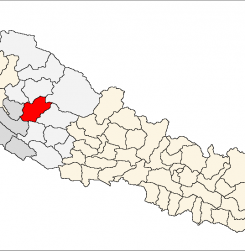
Online resources for reporting, follow-up on Jajarkot epidemic

So far, 282 people have lost their lives in Nepal’s Far West Region’s Diarrhoeal epidemic that began in early May. The most affected is Jajarkot district (141 deaths). Rukum has also suffered 46 deaths. In all, 19 districts are affected.
Since access is limited to the region due to difficult geography and the monsoon season, latest figures are not available and those that are available are updates mainly from the international relief agencies. The government’s official Websites have posted little, if any, information on the crisis.
The following links have been culled to help journalists locate relevant and valuable information to add facts, background and context to their reports on the continuing tragedy and the relief efforts:
LOCATION: Searchable Interactive AlterNet Map. A Bing map also provides an aerial and bird’s eye view of Jajarkot.
GRAPHICS: AReliefWeb map (last updated on 16 July, 2009) graphically showing the diarrhea outbreak areas, with casualty figures. A map showing the location of health camps, RelefWeb (20 July, 2009). District Public Health Office confirmed “111 diarrhea related deaths in Jajarkot District from 1 May to 16 July 2009. Access to remote affected areas is time consuming and delays delivery of medical supplies and health staff.”
FAMINE: Continuing food shortage (acute malnutrition) in Jajarkot (as well asKalikot,Humla, Mugu, Dolpa, Bajura, Achham, Dailekh,Rukum districts in the Far Western Region), has worsened the situation. This survey report from Ministry of Agriculture and Cooperatives/Government of Nepal and UN World Food Programme (July 2008) provides an overview of the famine: “The assessment found that the food security situation is indeed precarious in the affected areas of the districts and the situation is further exacerbated by the sharp rise in food and fuel costs seen in recent months. Yarsagumba collection from Dolpa is also a significant source of income supplementation, with a reported 20,000 people from Jajarkot alone traveling to Dolpa this season.” Jajarkot alone is short of 1589 mtin cereal production this year.
WHO REPORTS: The UN World Health Organization has an exclusive page with situation reportson the epidemic, with statistics on health camps, VDCs, people treated and sick as well as deaths. WHO’s reporting began on July 21, 2009. The first report notes “In Jajarkot district, currently 11 VDCs (out of 30 VDCs) reported exact number of 2190 cases with only 61 deaths.” There are 7 reports so far, the latest (10 August, 2009) summarizes the cumulative number of the treated and the dead since 1st May 2009.
DEATH TOLL: WHO’s latest death data on diarrhea – Jajarkot (141 deaths), Rukum (46), Dolpa (1), Rolpa (6), Salyan (3), Dailekh(17), Bajura (6), Dadeldhura (4), Doti (6), Surkhet (14 , Kanchanpur (1), Pyuthan (2), Makwanpur (0), Dang (0), Achham (17), Bajhang(7), Baitadi (9), Dhading (0), Kailali (2). “Access to the areas continue to be a challenge, the difficult terrain and bad weather conditions not only hampering the delivery of supplies to the affected districts and VDCs, but also making it difficult to monitor the delivery of the supplies to the population in need. The continuing monsoon season is expediting the spread of the disease to other districts, thereby enhancing the need for better surveillance.”
TIPS ON REPORTING: Journalists in Nepal (like in many other countries) are lacking in health reporting skills and support apparatus. These resources on Public Health reporting from Reuters are useful. The Reporting Health Website, based in the US, also offers relevant info.
OFFICIAL GOVERNMENT SITES: The Ministry of Health and Populationhas no updates on the diarrhea, but it does include the names of important newsmakers as well as health strategies and plans. For example, the Health Sector Strategy (2004) is available, but it does not specifically anticipate diarrhoeal outbreaks. The Department of Health Services (DoHS) also has no updates on the crisis, as of August 28, 2009.
RESEARCH AND ADVOCACY: Online information on the diarrhoeal health epidemic is not available in these Websites, but these lead to expert sources. For example, the Nepal Health Research Council, established to promote scientific study and quality research in health in Nepal, has a page with its executive members and another page with its Education Committee members. For more, you can contact them (Phone: 977-1-4254220/4227460). And here, too. Nepal Medical Council is another related source to follow.
There is also the Nepal Health Economics Association, which advocates a fair spending in the health sector. They can be contacted for relevant information (phone: 977-1-4423821, email: [email protected]). This page leads to NHEA members.
DIARRHEA INFO: Diarrhea Medical Factsfrom MedicineNet. FamilyDoctor.org also has some good recommendations. Also: Diarrhea facts for Travelers, from Center for Disease Control, USA. And this one is one man’s effort to affect lives for the better (blog of Brian Clark, a Diarrhea survivor himself). Diarrhea in history— a comprehensive overview by Matthew L. Lim, MD, Mark R. Wallace, MD, in Infect Dis Clin N Am 18 (2004) 261–274. Here is Google timeline for diarrhea worldwide.
OPEN SOURCE: Not always reliable info, but sometimes provides good updates—from Wikipedia.
STATISTICS: Health statistics online are not available easily. These links at HealthNet lead to some such stuff (outdated, in some cases, maybe).
SOME NEWSMAKERS: Umakanta Chaudhary, Minister for Health & Population (Phone: 977-1- 4262763/4262534. More contacts at Ministry here). National Health Education, Information, and Communication (Phone: 977-1- 4254673/4261387). Khyam Bahadur Thapa, Jajarkot Chief District Officer (Phone, District Administration Office: 089-649130133, fax 649130). Dr. Krishna Hari Subedi, Chief of the District Health office, Jajarkot. Rajeev Shah (a descendent of the Jajarkoti royalty), from the Jajarkot Cholera Disaster Coordination Committee. (mf)
To add resources, eyewitness accounts or significant sources to this list, please email us at [email protected]
Comment
© Media Foudation- 2024 | Site by: SoftNEP